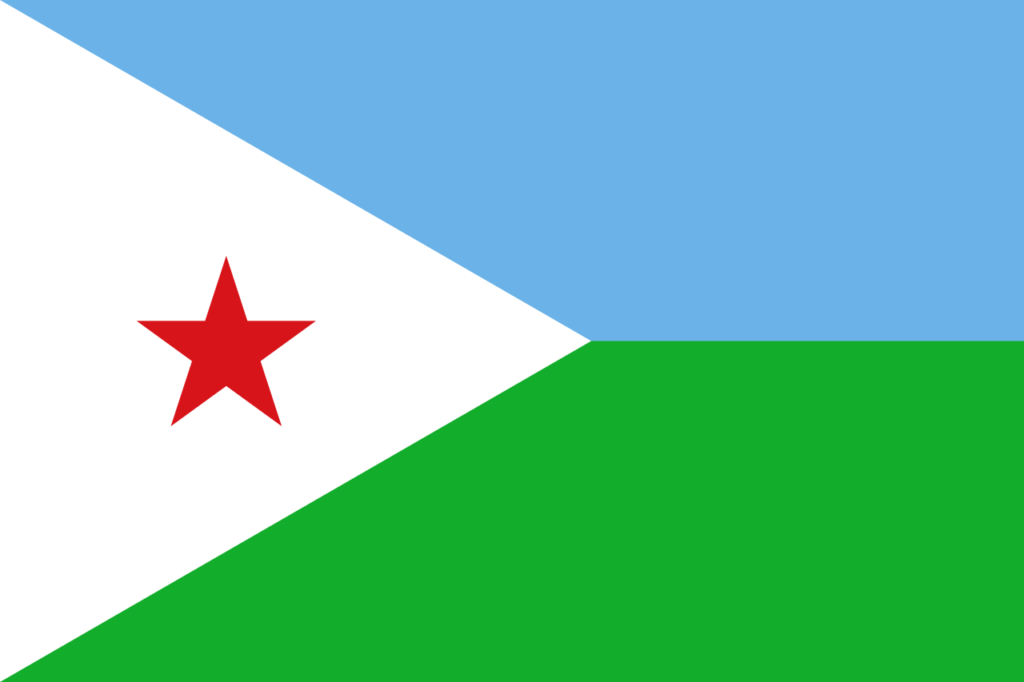Djibouti is a small state in northeast Africa. Its area is a little more than 23 thousand square kilometers. It is currently a republic with its own national symbols.
This is what the modern flag of Djibouti looks like:

History of the flag
In the late 1980s, the construction of the city of Djibouti began on land purchased by French emissaries from the Issa tribe. The French governor subsequently moved there. The governor’s banner, a blue cloth with two triangular ends (plaits) and the French tricolor, towered over the city.

In 1956, after mass demonstrations of Somalis in Djibouti, the French government passed a law expanding self-government of the overseas territory. An Executive Council was created, whose first vice-president, Issa Mahamoud Harbi Farah, created a new flag.
It was a rectangle consisting of two horizontal stripes. The top one was blue, like Somalia’s. The lower one, green, represented Islam. The red equilateral triangle at the stem signified the revolutionary struggle. The white five-pointed star on it was turned by one ray to the center of the cloth.

The modern flag of Djibouti, as the symbol of the state, was adopted on June 27, 1977. On this day Djibouti was finally freed from colonial dependence.
A similar cloth was raised over the country back in 1972 by the independence fighters. However, the meaning of the symbols has changed.
Description
It is a rectangle with a width to length ratio of 21:38. Horizontally, it is divided into two equal strips. The upper one is light blue. The bottom one is light green.
An equilateral white triangle has one side adjacent to the staff, with the corner directed toward the center.
In the middle of the triangle is a red star with five rays in a vertical position. The star is inscribed in an imaginary circle with a diameter of 1/5 of the width of the cloth.
Flag colors
Has the following colors:
- light blue or sky blue (Pantone 292c);
- Light green, (Pantone 361c);
- white;
- bright red, (Pantone 179c).
Meaning of colors and flag symbol
The light blue symbolizes the clear sea and boundless sky, and also represents the Issa people. Green symbolizes the nature of the African continent, the native land, lush vegetation and corresponds to the Afar people.
The white triangle symbolizes peace and harmony.
The red star is placed on the flag to commemorate the peoples’ struggle for independence from the colonizers. On the modern flag it symbolizes the unity of the people and society.
Other Flags
Flag of the National Union for Independence:

General information about Djibouti
| Official language | Arabic, French |
| Capital | Djibouti |
| Territory | 23 200 km² |
| Population | 818 169 people |
| Currency | Djibouti franc (DJF, code 268) |
| Phone Code | +253 |










I remember when I first saw the Djibouti flag during my travels. The blue and green colors were so vibrant against the desert backdrop! It reminded me of how unique and beautiful each country’s story and culture are, just like the flags that represent them. Such a cool experience!
As a guy named Michelle, I once saw the Djibouti flag at an airport and got curious. Learning about its colors and star really stuck with me. It’s cool how a flag can tell a whole story. Feeling grateful for moments like that that spark my wanderlust!
As a guy who’s into world flags, I once got so hooked learning about Djibouti’s flag colors. The blue stands for the sea and the sky, and the white symbolizes peace. Cool thing is, the red star represents unity — small flag, big meaning!
As a woman who loves flags, the Djibouti flag’s colors totally grab me! I once saw it waving at a cultural fest and felt the pride in its design. It’s cool how flags tell stories without words. Such a vibe!